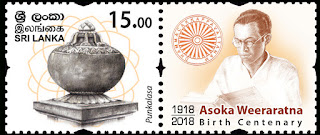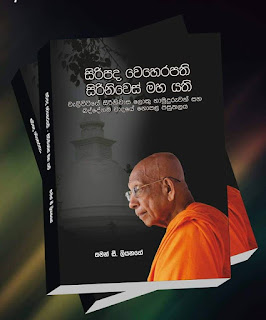BOOK REVIEW
TITLE : THE
KANDY ASALA MAHA PERAHARA
AUTHOR: LORNA
DEWARAJA
PUBLISHERS VIJITHA
YAPA PUBLICATIONS
REVIEWED BY HEMANTHA SITUGE
Email :
hsituge@gmail.com
The splendid opus entitled: The Kandy Asala Maha Perahera
written by Dr Lorna Devaraja published by the Vijitha Yapa Publications was
released recently.
This book is dedicated by her to her grand children
scattered all over the world. Dr Lorna
Srimathie Devaraja was an Associate Professor in History attached to the
University of Colombo, a historian of repute who passed away on 27th
November 2014.The book is a posthumous publication and the last book written by
her.
Dr Devaraja’s preface
of the book reads as follows :
“For a greater part of my life, I
have been interested in the history and the social institutions of the Kandyan
Kingdom. How half a million impoverished
souls, not particularly warlike, politically disturbed and economically
strangled withstood the attacks of three European powers at the height of their
prowess and preserved the independence of their country for three centuries has always been to me a
source of bewilderment. Since the Kandy Perahara is considered a microcosm of
Kandyan state and society, my interest quite naturally turned towards this
grand spectacle. However, it was not merely academic interest that prompted me
to write this book. Watching the calm and dignified manner with which the Maligava
tusker carried his sacred burden, majestically walking along the pavada or
white cloth laid at its feet: listening
to the rhythmic throb of the drums reverberating in the Kandyan hill slopes and observing the dignity and
decorum with which both man and beast behaved during the entire period of this
spectacular event evoked within me serene joy and emotion. Hence this book is
the result of both academic curiosity and aesthetic emotion.”
The book spans into sixty two glossy pages replete with
fifteen colour photographs and six
black and white photographs on the flags and banners of pure bliss.At pages 59-60 the book contains a bibiliography and
at pages 61-2 contains a glossary of used terms. The book is treatise paid by
her as a tribute to the motherland . Dr. Devaraja has profusely quoted from
Robert Knox, D.H.Lawrence , Dr. James Duncan , Dr. H.L. Seneviratne Prof Ralph
Peiris , Prof G.P. Malalasekara , Sir. Richard Aluvihare , Prof Anuradha
Seneviratne , Sir Richard Aluvihare and Major Jonathan Forbes.
Dr Devaraja’s words found in her preface is more apposite to ascertain the
contents of the book thus:
“This book consists of 10
chapters. Chapter One gives the vicissitudes of the Tooth Relic from the time
it left the funeral pyre of the Blessed one, its sojourn in India for eight
centuries and its arrival in Sri Lanka in the fourth century. Chapter Two
describes how the Tooth Relic became the palladium of sovereignty of the Sri
Lanka rulers and as the capitals charged the kings took the Relic with them
till it arrived at its final resting place in Kandy. In Chapter Three I have given an account of the Gods and
Festivals in the Kandyan Kingdom and the amalgamation of the Dalada Festival
with the Festivals of the Gods on the orders of King Kirti Sri Rajasimha.
Chapter four and five briefly deals with the State and Society in the Kandyan
Kingdom and the Dalada Maligava and its functionaries. Chapter Six,
Seven and Eight, which form the heart of the book give an in depth study of the
preperations for the Perahara, its composition in Kandyan times and its
significance and symbolism. Chapter Nine discusses the tragic repercussions on
the Perahara under the British. Chapter Ten shows how the Dalada Maligava is
trying its best to keep the Perahara going, retaining its sanctity,
despite all the challenges it has to face due to the political and
socio-economic changes of the present day. But in spite of such
devitations, Ceylon is Buddhist, and has
remained Buddhist through persecutions and persuastions, ravage and rewards,
bringandage and bribery. R.Raven Hart, Ceylon History in Stone, 1981.”
This reviewer has read and re-read this book. The reviewer
finds that the monograph merits his
comments cited below:
The earliest engraving of the perahera well-nigh two hundred
years old is executed by Lt.William Lyttleton is reproduced by her at pages xxii of
her book. The reviewer observes that R K de Silva's 19th Century Newspaper Engravings Serendib publication 1998 has published two engravings on the perahera in pages 80-82 which is culled from "The Graphic" July 25, 1885 . De Silva's book from pages 212-227, the account on the Dalada exhibited to the Prince are also found therein.The Perahera extracted from The illustrated London News dated 8th January 1876 where the Prince of Wales participated is found from Visions of an Island by Neville Weeraratne from the rare works from Sri lanka in the Christopher Ondaatji collection Harper Collins Ltd 1998 .
At page 41 Dr. Devaraja has stated that ‘the account of Dr.
John Davy and Charles Pridham is heresay’. Davy came to SriLanka in August 1816
see: preface xi John Davy’s An account King
Sri Wickrama Rajasinha was sent in exile in 24th January 1816 as he
was captured on 18th February 1815.It is evident therefore that Davy
was not in Ceylon during the tenure of the last king , and the his comment that
were based on eleven months after.It is
the bone of contention put forward by this reviewer that on account of hearsay
itself Davy’s account could not be rejected as he could have some veracity of contents recorded
by him.Charles Pridham like Rev. Robert Fellowes and Frederic Moore never
sighted Ceylon . As Davy was published by 1821 his account would have been based on his account.
At page 50 of Dr Devaraja ‘s book she has stated that:
“ The Kandyan Convention was signed on 3rd March
1815 amidst brilliant scenes in the Hall of Audience of the Kandyan
Kings……..”The Kandyan Convention was never signed on 2nd March 1815.
The date 3rd March as stated by Dr. Devaraja should be considered as
a lapsus calamai or lapsus pennae.
What this reviewer cannot comprehend is that the king who
was sent on exile has not placed his signature to the Tamil translated version
of the Kandyan Convention and it was only his retinue who has done so . vide :
Journal of the Royal Asiatic Society NS Volume xi ,1967 from pages 78-92 the article titled: A Critical Edition of the Tamil Documents Relating to the Deportation of the
Sri Vickrama Rajasimha’s Relatives by S. Thananjayarajasingham.
At page 56 Dr. Devaraja has stated that:" ......The Paddy Lands Act of 1956 further diminished the power of the "Monastic Landlords" to receive the tenurial obligations from the Tenants of the Temple Lands...."It is the fervent view of this reviewer that The Nindagama Lands Act No 30 of 1968 ( Chapter 301) Legislative Enactments Volume XI pages 435-440 unofficial 1980 is 'An act to abolish the services due from the tenants and holders of Nindagama Lands to the Proprietors thereof, to make such tenants and Holders the absolute owners of such lands , to provide for the registration of such tenants and holders as absolute owners thereof .....' This statute came into force from 3rd January 1970 was more a contributory factor than the Paddy Lands Act which 'diminished the power of monastic landlords'.
It is the fervent view of the reviewer that Dr. Devaraja should have sought recourse to two scholarly Sinhalese works on the subject. They are viz:Dalada Ithihasaya saha Sanskruthiya -The History of the Tooth Relic and the Culture- by Rev Kamburugamuwe Vajira , the Phd thesis submitted by him to the University of Peradeniya in 1974 published in 1983 by Tisara publications and a more recent work by Rev Walasmulle Wimalagnagna titled: Sri Dalada Vahanse saha Ashritha Puja Vidi -The Tooth Relic of Lord Buddha and the Rites associated with it -Godage publications 2013 .
Ven. Dr Vajira's excellent exposition has brought into light that the accounts on the advent of the Tooth Relic of Lord Buddha found in the epic such as Mahawamsa and Dathawamsa is amply corroborated by archaeological evidence as elicited by Prof Amaradasa Liyanagamaga in his Phd thesis published titled: "The Decline of Polonnaruwa and the Rise of Dambadeniya Dept. of Cultural Affairs in 1968.
The reviewer finds that in all these scholars and writers have not considered J. Gerson da Cunha's monograph entitled:' Memoir on the History of the Tooth Relic of Ceylon' London in 1875 reprinted by AES publications in 2001.
Dr Devaraja's erudite treatise entitled: " The Kandy Asala Maha Perahera" would serve as a vade maecum on the Asala Perahera . This excellent opus undoubtedly, is a true tribute by Dr Devaraja to her motherland and a bid adieu before her departure from us in the long journey of samsara.
At page 56 Dr. Devaraja has stated that:" ......The Paddy Lands Act of 1956 further diminished the power of the "Monastic Landlords" to receive the tenurial obligations from the Tenants of the Temple Lands...."It is the fervent view of this reviewer that The Nindagama Lands Act No 30 of 1968 ( Chapter 301) Legislative Enactments Volume XI pages 435-440 unofficial 1980 is 'An act to abolish the services due from the tenants and holders of Nindagama Lands to the Proprietors thereof, to make such tenants and Holders the absolute owners of such lands , to provide for the registration of such tenants and holders as absolute owners thereof .....' This statute came into force from 3rd January 1970 was more a contributory factor than the Paddy Lands Act which 'diminished the power of monastic landlords'.
It is the fervent view of the reviewer that Dr. Devaraja should have sought recourse to two scholarly Sinhalese works on the subject. They are viz:Dalada Ithihasaya saha Sanskruthiya -The History of the Tooth Relic and the Culture- by Rev Kamburugamuwe Vajira , the Phd thesis submitted by him to the University of Peradeniya in 1974 published in 1983 by Tisara publications and a more recent work by Rev Walasmulle Wimalagnagna titled: Sri Dalada Vahanse saha Ashritha Puja Vidi -The Tooth Relic of Lord Buddha and the Rites associated with it -Godage publications 2013 .
Ven. Dr Vajira's excellent exposition has brought into light that the accounts on the advent of the Tooth Relic of Lord Buddha found in the epic such as Mahawamsa and Dathawamsa is amply corroborated by archaeological evidence as elicited by Prof Amaradasa Liyanagamaga in his Phd thesis published titled: "The Decline of Polonnaruwa and the Rise of Dambadeniya Dept. of Cultural Affairs in 1968.
The reviewer finds that in all these scholars and writers have not considered J. Gerson da Cunha's monograph entitled:' Memoir on the History of the Tooth Relic of Ceylon' London in 1875 reprinted by AES publications in 2001.
Dr Devaraja's erudite treatise entitled: " The Kandy Asala Maha Perahera" would serve as a vade maecum on the Asala Perahera . This excellent opus undoubtedly, is a true tribute by Dr Devaraja to her motherland and a bid adieu before her departure from us in the long journey of samsara.

















